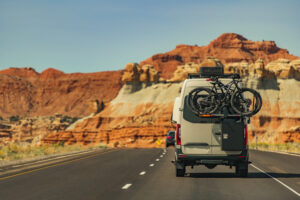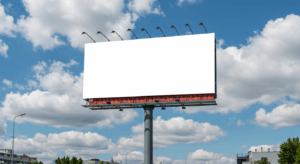When Weather Becomes the Message: How Outdoor Ads Can Adapt to the Elements
Weather conditions play a significant role in outdoor advertising. Rain, snow, heat, and even wind can impact billboard visibility, durability, and effectiveness. But instead of treating the weather as a challenge, advertisers can use it to their advantage—creating dynamic, weather-responsive campaigns that engage audiences in real time.
In this blog, we’ll explore how billboards can adapt to different weather conditions, the benefits of weather-triggered advertising, and best practices for making outdoor ads resilient and impactful year-round.
The Impact of Weather on Outdoor Advertising
Weather affects billboards in multiple ways, including visibility, audience behavior, and structural integrity. Understanding these factors helps advertisers make informed decisions about design, placement, and durability.
1. Visibility and Readability
- Rain and fog can reduce visibility, making high-contrast colors and bold typography essential.
- Bright sunlight can cause glare or fading, so UV-resistant materials and anti-glare coatings help maintain visibility.
- Snow and ice can cover billboards in colder climates, making elevated or digital boards more effective.
2. Audience Mood and Purchasing Behavior
- Cold weather drives demand for winter apparel, hot drinks, and indoor entertainment.
- Hot weather increases interest in cold beverages, outdoor activities, and seasonal products.
- Storms and extreme conditions can trigger real-time, need-based purchases, such as umbrellas, emergency services, or hotel bookings.
3. Physical Durability
- Strong winds and heavy rain can damage billboards if they aren’t designed for resilience.
- Metal and UV-resistant vinyl extend the life of traditional billboards in harsh conditions.
- Digital billboards must be weatherproof to withstand high humidity, storms, or extreme heat.
How Billboards Can Adapt to Real-Time Weather Conditions
Modern outdoor advertising is no longer static. Weather-triggered billboards use real-time data to change messages based on current conditions, making them more relevant and engaging.
1. Digital Billboards with Weather-Responsive Ads
Digital billboards can adjust messaging dynamically based on live weather updates.
Examples:
- A coffee brand can display “Cold morning? Warm up with our fresh brew!” when temperatures drop below a certain level.
- A sunglasses retailer can promote “Sunny skies ahead—protect your eyes!” on hot, bright days.
- A raincoat company can trigger “Stay Dry Today—Rain Jackets in Stock!” whenever rain is detected.
2. Interactive & Smart Billboards
Some billboards incorporate sensors or live data feeds to interact with weather changes.
Examples:
- A clothing brand in New York placed a billboard that changed outfits on a digital model based on real-time temperature shifts.
- A beer company in Brazil designed a billboard that dispensed free cold drinks when the temperature exceeded a certain threshold.
3. Eco-Friendly, Solar-Powered Billboards
Many modern billboards are now designed to adapt to changing environmental conditions while maintaining sustainability.
Examples:
- Solar-powered digital billboards ensure consistent performance during storms and power outages.
- UV-resistant vinyl extends the life of traditional billboards in high-sunlight regions.
- Rainwater-absorbing billboards have been used to purify air and reduce pollution in urban areas.
4. Seasonal Billboards That Rotate Messages
Advertisers can pre-schedule different billboard creatives to align with seasonal weather trends.
Examples:
- A sportswear company may feature running shoes in spring, sandals in summer, and hiking boots in fall.
- A home improvement retailer could promote snowblowers in winter, gardening supplies in spring, and AC units in summer.
Best Practices for Weather-Resistant Billboards
To ensure outdoor ads remain effective and durable, businesses should follow best practices in billboard design and material selection.
1. Use Weather-Resistant Materials
- Vinyl with UV protection prevents fading from sun exposure.
- Aluminum structures resist rust and withstand extreme weather.
- Wind-perforated billboard designs allow air to pass through, reducing storm damage.
2. Optimize Design for All Weather Conditions
- High-contrast colors ensure visibility in fog, rain, and bright sunlight.
- Bold, simple fonts improve readability even when visibility is low.
- Strategic lighting enhances night-time and stormy weather visibility.
3. Choose Strategic Locations
- Elevated billboards are less likely to be blocked by snowdrifts or floods.
- Digital billboards should be placed where glare and sun reflection won’t impact readability.
- Avoid placing billboards in areas prone to extreme weather damage unless they are reinforced.
4. Consider Regional Weather Trends
- In rainy cities like Seattle, advertisers should focus on waterproof materials and messaging tailored to frequent rain.
- In hot, sunny states like Arizona, billboards should use heat-resistant materials and avoid designs that may warp or fade.
- In snowy regions like Minnesota, elevated placements help keep billboards visible above snow accumulation.
How Weather-Adaptive Billboards Boost Engagement and Sales
Weather-responsive outdoor ads do more than just survive extreme conditions—they enhance engagement by making messaging more timely, relevant, and actionable.
1. Increased Relevance = Higher Engagement
People are more likely to notice and respond to billboards that align with their immediate environment and needs.
- On a hot summer day, an ad for cold drinks has a much higher impact.
- During rainstorms, umbrella and raincoat promotions become immediately relevant.
2. Real-Time Messaging Creates a Sense of Urgency
When an ad speaks directly to current weather conditions, it prompts faster decision-making.
- A ski resort billboard can update snowfall conditions to drive bookings.
- A hotel chain billboard can promote “Stay Safe from the Storm—Book a Room Ahead.”
3. Competitive Advantage
Brands that incorporate weather-triggered advertising gain an edge by delivering hyper-relevant messaging while competitors run generic ads.
- A pharmacy billboard displaying “Flu Season is Here—Get Your Shot Today!” will outperform an ad that isn’t tied to current conditions.
Turning Weather into an Advertising Advantage
Outdoor advertising doesn’t have to be at the mercy of the elements—it can use the elements to create dynamic, engaging, and effective campaigns.
By leveraging real-time weather data, choosing weather-resistant materials, and strategically adapting billboard messaging, businesses can ensure their outdoor ads remain high-impact year-round.
Effortless Outdoor Media helps brands develop weather-adaptive billboard campaigns that maximize engagement and ROI.
Looking for a billboard strategy that works in all conditions?
Contact Bill Hobbs at Effortless Outdoor Media today to create a weather-proof, high-impact outdoor campaign.
“If you are in need of expert advice and knowledge about billboards in the Atlanta market, Bill Hobbs brings tremendous value.” | From Dan Jape, Owner of RELIABLE HEATING AND AIR.




